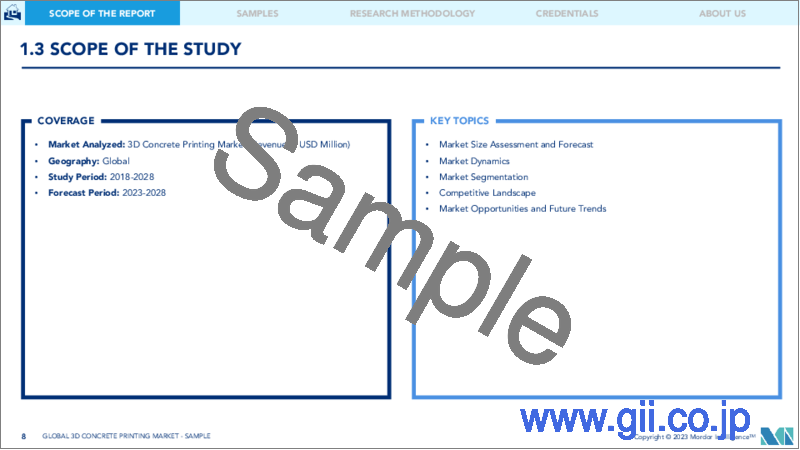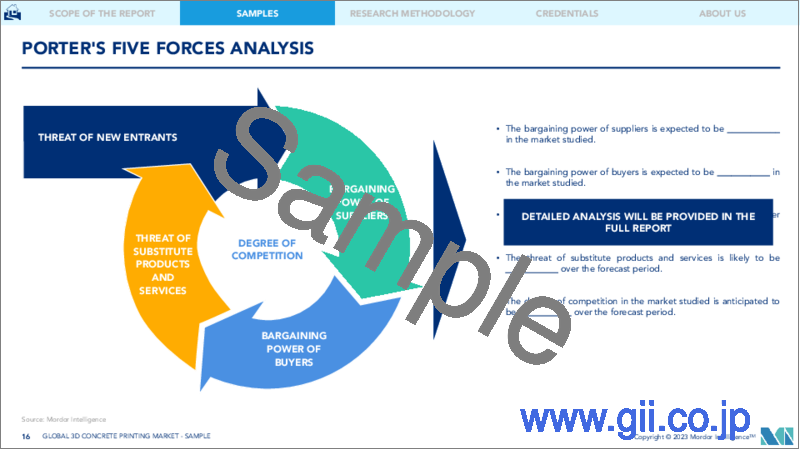|
|
市場調査レポート
商品コード
1195535
3Dコンクリートプリンティング市場- 成長、動向、予測(2023年-2028年)3D Concrete Printing Market - Growth, Trends, and Forecasts (2023 - 2028) |
||||||
|
● お客様のご希望に応じて、既存データの加工や未掲載情報(例:国別セグメント)の追加などの対応が可能です。 詳細はお問い合わせください。 |
|||||||
| 3Dコンクリートプリンティング市場- 成長、動向、予測(2023年-2028年) |
|
出版日: 2023年01月23日
発行: Mordor Intelligence
ページ情報: 英文 120 Pages
納期: 2~3営業日
|
- 全表示
- 概要
- 目次
3Dコンクリートプリンティング市場は、予測期間中に65%以上のCAGRで成長すると予想されます。
COVID-19は、ロックダウンと建設プロジェクトの延期によってもたらされた資本不足により、2020年の市場にマイナスの影響を与えました。パンデミックのため、商業および住宅建設プロジェクトに対する新規投資が大幅に減少し、需要の減少、キャッシュフローの制限、失業率の上昇を招いています。しかし、予測期間中は建築・建設活動が活発化し、市場は安定的に成長すると予想されます。
主なハイライト
- 短期的には、カスタマイズされた費用対効果の高い建築物に対する需要の増加、急速な都市化と工業化によるインフラ投資の拡大、環境に優しくスマートな建築物への注目の高まりが、調査対象市場の成長を促す主要因となっています。
- しかし、先進国における産業成長の停滞は、予測期間中に対象産業の成長を抑制すると予想される主要な要因です。
- しかしながら、アジア太平洋地域の3Dプリント市場、特に中国における技術革新の高まりと、強化3Dコンクリートプリントの開発は、間もなく世界市場に有利な成長機会を生み出すと思われます。
- アジア太平洋は、小規模住宅やその他のインフラプロジェクトの建設により、3Dコンクリートプリンティング市場の予測期間中に健全な成長を示すと推定されます。
3Dコンクリートプリンティングの市場動向
インフラ部門が市場を独占
- 3Dコンクリートプリンティングのインフラ市場は、特にアジア太平洋地域やその他の成長国において大きく成長しています。インドなどでは、インフラ部門がタウンシップ、住宅、築造インフラ、建設開発プロジェクトなどの関連産業の拡大を推進し、インドの経済成長の促進要因として機能しています。
- 2021年には、住宅建設における3Dプリンティングの利用が急増しました。都市化の急速な進展に伴い、複数の成長国でインフラ構造物の迅速な建設が求められるようになっています。
- 2022年10月、MiCoB Pvt.Ltdは、プネーにある空軍基地の軍事技術サービスに対して、3Dコンクリートプリンティングによる滑走路制御小屋の納品速度30日という記録を達成したと発表しました。完成した建物は、3Dコンクリートプリントとプレハブ鉄骨を組み合わせた、インド初のハイブリッド「G+1」構造です。
- Project Milestoneは、Houben/Van Mierlo Architectsが設計した5つの3Dプリント構造体からなる、オランダのアイントホーフェンに計画された住宅団地です。2021年4月現在、最初の構造体である平屋建ての一戸建て住宅が建設されています。
- IBEFによると、2022-23年度連邦予算において、政府はインフラ部門の強化のために10 lakh crore(1305.7億米ドル)を割り当て、インフラ部門を大幅に後押ししたとのことです。
- インドは、"National Infrastructure Pipeline"を通じて1.4兆米ドルをインフラに投資する意向です。21年度のインフラ関連事業は、FDI流入額全体の817億2,000万米ドルのうち13%を占めています。
- したがって、上記の要因は、予測期間中に3Dコンクリートプリンティングの需要を促進することが期待されます。
アジア太平洋地域が市場を独占する
- アジア太平洋地域の建設部門は世界最大であり、人口増加、中間所得層の増加、都市化により、健全な速度で増加しています。インフラ建設活動の活発化は、アジア太平洋地域の建設セクターの主要な促進要因となっています。
- 中国は、アジア太平洋地域の主要国の1つで、政府の強力な支援、標準化への取り組み、アプリケーション分野の拡大により、3Dコンクリートプリントの主要消費国として台頭してきました。
- 例えば、中国の清華大学建築学部のチームは、3Dプリントされた橋としては世界最長とされる長さ26.3mのコンクリート橋を建設しました。2台のロボットアーム型3Dプリントシステムで、450時間以内に176個のコンクリート部品を作成し、新しい3Dプリント橋を完成させました。
- インドでは、人口増加に伴う住宅不足が大きな問題となっていますが、3Dプリンティング技術はその解決策としても有効なようです。例えば、チェンナイに拠点を置くTvasta Manufacturing Solutions社は、最近3Dプリンターを使って500平方フィートの住宅を21日間で完成させました。
- Ipsos Global Infrastructure Investor Associationによると、2021年、中国では77%の回答者が国のインフラに非常に満足している、またはまあまあ満足していると回答しています。さらに、マレーシアでは45%の回答者がマレーシアの国家インフラに「とても満足している」「まあ満足している」と回答しています。
- このように、アジア太平洋地域では建設活動が活発化しており、3Dコンクリートプリンティング市場を後押しすることが期待されています。
3Dコンクリートプリンティング市場の競合他社分析
3Dコンクリートプリンティング市場は、統合された市場です。市場の主要プレイヤーは、Yingchuang Building Technique(Shanghai)(WinSun)、COBOD、Apis Cor Inc、ICON Technology Inc、WASP Srl-Via Castellettoなどです(順不同)。
その他の特典
- エクセル形式の市場予測(ME)シート
- アナリストによる3ヶ月間のサポート
目次
第1章 イントロダクション
- 調査の前提条件
- 調査範囲
第2章 調査手法
第3章 エグゼクティブサマリー
第4章 市場力学
- 促進要因
- カスタマイズされた費用対効果の高い建築物への需要の高まり
- 急速な都市化・工業化に伴うインフラ投資の増加
- 環境に配慮したスマートな建築物への注目の高まり
- 抑制要因
- 先進国における産業成長の停滞
- 産業バリューチェーン分析
- ポーターのファイブフォース分析
- 供給企業の交渉力
- 買い手の交渉力
- 新規参入業者の脅威
- 代替品の脅威
- 競合の度合い
第5章 市場セグメンテーション(市場規模(金額ベース)
- コンクリート種類別
- 生コン
- 高性能コンクリート
- プレキャスト
- 吹付けコンクリート
- エンドユーザー部門
- 住宅分野
- 商業施設
- インフラストラクチャー
- 建築
- 地域別
- アジア太平洋地域
- 中国
- インド
- 日本
- 韓国
- ASEAN諸国
- その他アジア太平洋地域
- 北米
- 米国
- カナダ
- メキシコ
- 欧州
- ドイツ
- 英国
- フランス
- 北欧諸国
- オランダ
- その他の欧州地域
- 南米地域
- ブラジル
- アルゼンチン
- その他の南米地域
- 中東地域
- GCC諸国
- 南アフリカ共和国
- その他の中東地域
- アジア太平洋地域
第6章 競合情勢
- M&A、合弁事業、協業、協定
- 市場ランキング分析
- リーディングプレイヤーが採用する戦略
- 企業プロファイル
- Apis Cor Inc.
- COBOD
- CyBe Construction
- HEIDELBERGCEMENT AG
- ICON Technology Inc.
- HOLCIM
- MUDBOTS 3D CONCRETE PRINTING LLC
- Sika AG
- Skanska
- WASP Srl-Via Castelletto
- XtreeE
- Yingchuang Building Technique(Shanghai)Co. Ltd(WinSun)
第7章 市場機会と今後の動向
- アジア太平洋地域の3Dプリンティング市場、特に中国における技術革新の活発化
- 強化型3Dコンクリートプリンティングの発展
The 3D concrete printing market is expected to grow with a CAGR of over 65% during the forecast period.
COVID-19 negatively impacted the market in 2020 due to the capital shortages brought on by the lockdowns and postponed construction projects. Due to the pandemic, new investments in commercial and residential construction projects have substantially decreased, reducing demand, restricting cash flow, and increasing unemployment. However, the market is projected to grow steadily, owing to increased building and construction activities during the forecast period.
Key Highlights
- Over the short term, increasing demand for customized money-efficient constructions, growing investments in infrastructure due to rapid urbanization and industrialization, and increasing focus on eco-friendly and smart constructions are major factors driving the growth of the market studied.
- However, stagnant industrial growth in developed countries is a key factor anticipated to restrain the growth of the target industry over the forecast period.
- Nevertheless, increasing innovations in the Asia-Pacific 3D printing market, especially in China, and the development of reinforced 3D concrete printing are likely to create lucrative growth opportunities for the global market soon.
- The Asia-Pacific is estimated to witness healthy growth over the forecast period in the 3D concrete printing market due to the construction of small-scale residential and other infrastructure projects.
3D Concrete Printing Market Trends
Infrastructural Sector to Dominate the Market
- The infrastructural market for 3D concrete printing has grown significantly, particularly in Asia-Pacific and other growing nations. In nations like India, the infrastructure sector propels the expansion of related industries like townships, housing, built-up infrastructure, and construction development projects, acting as a driver for economic growth in India.
- In 2021, the use of 3D printing in home construction surged. As a result of the rapid growth in urbanization, a need for faster construction of infrastructural structures emerged in several growing countries.
- On October 2022, MiCoB Pvt. Ltd stated that it had achieved a record delivery speed of 30 days for a 3D concrete printed runway controller hut to the Military Engineer Services for the Airbase in Pune. The finished building is India's first hybrid "G+1" structure to combine 3D concrete printing with a prefabricated steel frame.
- Project Milestone is a projected residential complex in Eindhoven, the Netherlands, consisting of five 3D-printed structures designed by Houben/Van Mierlo Architects. The first structure, a single-story single-family dwelling, has been built as of April 2021.
- According to IBEF, in the union budget 2022-23, the government has given a massive push to the infrastructure sector by allocating INR 10 lakh crore (USD 130.57 billion) to enhance the infrastructure sector.
- India intends to invest USD 1.4 trillion in infrastructure through its "National Infrastructure Pipeline." Infrastructure-related operations in FY21 contributed 13% of the USD 81.72 billion in overall FDI inflows.
- Thus, the abovementioned factors are expected to drive the demand for 3D concrete printing during the forecast period.
Asia-Pacific Region to Dominate the Market
- The Asia-Pacific construction sector is the largest in the world and is increasing at a healthy rate, owing to the rising population, increase in middle-class income, and urbanization. Increasing infrastructure construction activity is the major driver for the Asia-Pacific construction sector.
- China is one of the leading countries in the Asia-Pacific region that emerged as a major 3D concrete printing consumer due to strong government support, efforts toward standardization, and expanding application segments.
- For instance, a team from Tsinghua University's School of Architecture in China constructed a 26.3-meter-long concrete bridge, which is considered to be the world's longest 3D-printed bridge. In less than 450 hours, two robotic-arm 3D printing systems created 176 concrete components for the new 3D-printed bridge.
- In India, 3D printing technology appears to be an effective solution to the housing scarcity problem, which has been one of the primary worries in the past owing to population growth. For example, Tvasta Manufacturing Solutions, a Chennai-based business, recently completed a 500-square-foot house in 21 days using a 3D printer.
- According to Ipsos Global Infrastructure Investor Association, in 2021, 77% of respondents in China stated that they were very or fairly satisfied with the national infrastructure. Moreover, 45% of respondents in Malaysia said that they were either very or fairly satisfied with Malaysian national infrastructure.
- Thus, construction activity has been growing in the Asia-Pacific, which is expected to boost the 3D concrete printing market.
3D Concrete Printing Market Competitor Analysis
The 3D concrete printing market is a consolidated market. Key players in the market include Yingchuang Building Technique (Shanghai) Co. Ltd (WinSun), COBOD, Apis Cor Inc., ICON Technology Inc., and WASP Srl - Via Castelletto, among others (not in any particular order).
Additional Benefits:
- The market estimate (ME) sheet in Excel format
- 3 months of analyst support
TABLE OF CONTENTS
1 INTRODUCTION
- 1.1 Study Assumptions
- 1.2 Scope of the Study
2 RESEARCH METHODOLOGY
3 EXECUTIVE SUMMARY
4 MARKET DYNAMICS
- 4.1 Drivers
- 4.1.1 Increasing Demand for Customized and Money Efficient Constructions
- 4.1.2 Increasing Investments in Infrastructure due to Rapid Urbanization and Industrialization
- 4.1.3 Increasing Focus on Eco-friendly and Smart Constructions
- 4.2 Restraints
- 4.2.1 Stagnant Industrial Growth in the Developed Countries
- 4.3 Industry Value Chain Analysis
- 4.4 Porter's Five Forces Analysis
- 4.4.1 Bargaining Power of Suppliers
- 4.4.2 Bargaining Power of Buyers
- 4.4.3 Threat of New Entrants
- 4.4.4 Threat of Substitute Products and Services
- 4.4.5 Degree of Competition
5 MARKET SEGMENTATION (Market Size by Value)
- 5.1 By Concrete Type
- 5.1.1 Ready-mix
- 5.1.2 High Performance
- 5.1.3 Precast
- 5.1.4 Shotcrete
- 5.2 End-use Sector
- 5.2.1 Residential
- 5.2.2 Commercial
- 5.2.3 Infrastructural
- 5.2.4 Architectural
- 5.3 Geography
- 5.3.1 Asia-Pacific
- 5.3.1.1 China
- 5.3.1.2 India
- 5.3.1.3 Japan
- 5.3.1.4 South Korea
- 5.3.1.5 ASEAN Countries
- 5.3.1.6 Rest of Asia-Pacific
- 5.3.2 North America
- 5.3.2.1 United States
- 5.3.2.2 Canada
- 5.3.2.3 Mexico
- 5.3.3 Europe
- 5.3.3.1 Germany
- 5.3.3.2 United Kingdom
- 5.3.3.3 France
- 5.3.3.4 Nordic Countries
- 5.3.3.5 The Netherlands
- 5.3.3.6 Rest of Europe
- 5.3.4 South America
- 5.3.4.1 Brazil
- 5.3.4.2 Argentina
- 5.3.4.3 Rest of South America
- 5.3.5 Middle East
- 5.3.5.1 GCC Countries
- 5.3.5.2 South Africa
- 5.3.5.3 Rest of Middle East
- 5.3.1 Asia-Pacific
6 COMPETITIVE LANDSCAPE
- 6.1 Mergers and Acquisitions, Joint Ventures, Collaborations, and Agreements
- 6.2 Market Ranking Analysis
- 6.3 Strategies Adopted by Leading Players
- 6.4 Company Profiles
- 6.4.1 Apis Cor Inc.
- 6.4.2 COBOD
- 6.4.3 CyBe Construction
- 6.4.4 HEIDELBERGCEMENT AG
- 6.4.5 ICON Technology Inc.
- 6.4.6 HOLCIM
- 6.4.7 MUDBOTS 3D CONCRETE PRINTING LLC
- 6.4.8 Sika AG
- 6.4.9 Skanska
- 6.4.10 WASP Srl - Via Castelletto
- 6.4.11 XtreeE
- 6.4.12 Yingchuang Building Technique (Shanghai) Co. Ltd (WinSun)
7 MARKET OPPORTUNITIES AND FUTURE TRENDS
- 7.1 Increasing Innovations in the Asia-Pacific 3D Printing Market, Especially China
- 7.2 Development of Reinforced 3D Concrete Printing




